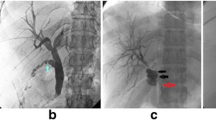Abstract
Symptomatic biliary leakage following major upper abdominal surgery is a severe complication resulting in increased morbidity and mortality. Treatment options usually include either endoscopic intervention or surgical revision. These options may be burdened by a high perioperative risk for the patient (e.g., patients with severe disease) or simply may not be possible (e.g., nonpreserved gastroduodenal passage). In the past, percutaneous transhepatic cholangiodrainage did only seem to be a viable option for patients with dilated bile ducts. Here, we present our experience in a consecutive series of patients with symptomatic biliary leakage following major upper abdominal surgery and without dilation of the biliary system that underwent percutaneous transhepatic cholangiodrainage. Percutaneous transhepatic cholangiodrainage was feasible in 15 of 18 patients (83.3%). The procedure was technically not possible in three patients (16.7%). In 10 of the 15 patients (66.6%) with feasible percutaneous transhepatic cholangiodrainage, biliary leakage was definitely controlled without the need for surgical revision. Depending on the experience with the interventional procedure, percutaneous transhepatic cholangiodrainage should be considered as an alternative for treatment of symptomatic biliary leakage instead of immediate reoperation.




Similar content being viewed by others
References
Hopt UT, Makowiec F, Adam U. Leakage after biliary and pancreatic surgery. Chirurg 2004;75:1079–1087.
Adam U, Makowiec F, Riediger H, et al. Risk factors for complications after pancreatic head resection. Am J Surg 2004; 187:201–208.
Yeo CJ, Cameron JL, Sohn TA, et al. Six hundred fifty consecutive pancreaticoduodenectomies in the 1990s: pathology, complications, and outcomes. Ann Surg 1997;226:248–257; discussion 257–260.
Rios G, Conrad A, Cole D, et al. Trends in indications and outcomes in the Whipple procedure over a 40-year period. Am Surg 1999;65:889–893.
Ghahremani GG. Postsurgical biliary tract complications. Gastroenterologist 1997;5:46–57.
Sohn TA, Yeo CJ, Cameron JL, et al. Pancreaticoduodenectomy: role of interventional radiologists in managing patients and complications. J Gastrointest Surg 2003;7:209–219.
Nakeeb A, Pitt HA. The role of preoperative biliary decompression in obstructive jaundice. Hepatogastroenterology 1995;42:332–337.
Pitt HA, Gomes AS, Lois JF, et al. Does preoperative percutaneous biliary drainage reduce operative risk or increase hospital cost? Ann Surg 1985;201:545–553.
Povoski SP, Karpeh MS Jr., Conlon K C, et al. Association of preoperative biliary drainage with postoperative outcome following pancreaticoduodenectomy. Ann Surg 1999;230:131–142.
Pisters PW, Hudec WA, Hess KR, et al. Effect of preoperative biliary decompression on pancreaticoduodenectomy-associated morbidity in 300 consecutive patients. Ann Surg 2001;234:47–55.
Sohn TA, Yeo CJ, Cameron JL, et al. Do preoperative biliary stents increase postpancreaticoduodenectomy complications? J Gastrointest Surg 2000;4:258–267; discussion 67–68.
Bose SM, Mazumdar A, Singh V. The role of endoscopic procedures in the management of postcholecystectomy and posttraumatic biliary leak. Surg Today 2001;31:45–50.
Kromer MU, Maier M, Benz CA, et al. Bile duct stenoses and leakage after cholecystectomy: endoscopic diagnosis, therapy and treatment outcome. Z Gastroenterol 1996;34:167–172.
Dawson SL, Mueller PR. Interventional radiology in the management of bile duct injuries. Surg Clin N Am 1994;74:865–874; discussion 75–81.
Vaccaro JP, Dorfman GS, Lambiase RE. Treatment of biliary leaks and fistulae by simultaneous percutaneous drainage and diversion. Cardiovasc Intervent Radiol 1991; 14:109–112.
Chen XP, Peng SY, Peng CH, et al. A ten-year study on non-surgical treatment of postoperative bile leakage. World J Gastroenterol 2002;8:937–942.
Suehiro M, Ishimura J, Fukuchi M. Detection of bile leakage into the thoracic cavity by hepatobiliary scintigraphy. Ann Nucl Med 1991;5:167–169.
de Castro SM, Kuhlmann KF, Busch OR, et al. Incidence and management of biliary leakage after hepaticojejunostomy. J Gastrointest Surg 2005;9:1163–1171, discussion, 71–73.
Author information
Authors and Affiliations
Corresponding author
Rights and permissions
About this article
Cite this article
Link, BC., Yekebas, E.F., Bogoevski, D. et al. Percutaneous Transhepatic Cholangiodrainage as Rescue Therapy for Symptomatic Biliary Leakage Without Biliary Tract Dilation After Major Surgery. J Gastrointest Surg 11, 166–170 (2007). https://doi.org/10.1007/s11605-006-0074-y
Published:
Issue Date:
DOI: https://doi.org/10.1007/s11605-006-0074-y




